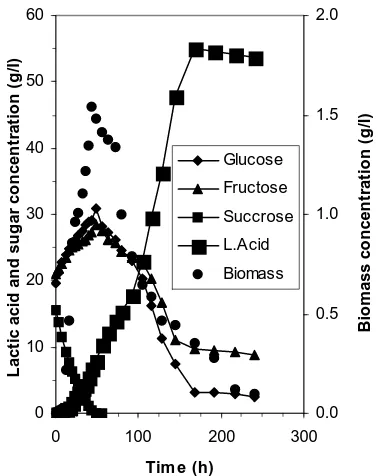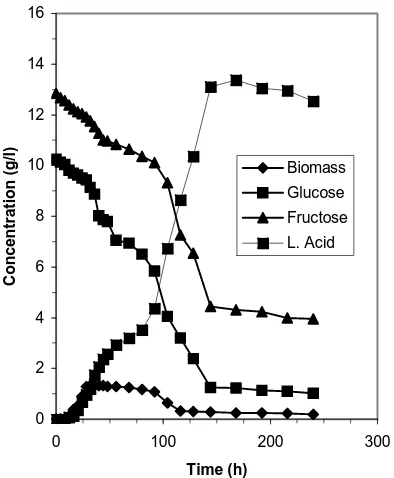Reaktor, Vol. 11 No.1, Juni 2007, Hal. : 50-52
SOLID AND LIQUID PINEAPPLE WASTE UTILIZATION
FOR LACTIC ACID FERMENTATION
USING Lactobacillus delbrueckii
Abdullah
*)Abstract
The liquid and solid pineapple wastes contain mainly sucrose, glucose, fructose and other nutrients. It therefore can potentially be used as carbon source for fermentation to produce organic acid. Recently, lactic acid has been considered to be an important raw material for production of biodegradable lactate polymer. The experiments were carried out in batch fermentation using the liquid and solid pineapple wastes to produce lactic acid. The anaerobic fermentation of lactic acid were performed at 40 oC, pH 6, 5% inocolum and 50 rpm. Initially results show that the liquid pineapple waste by using Lactobacillus delbrueckii can be used as carbon source for lactic acid fermentation. The production of lactic acid are found to be 79 % yield, while only 56% yield was produced by using solid waste.
Keywords : Lactic acid fermentation, Pineapple waste, Lactobacillus delbrueckii.
Introduction
Pineapple canning industries located in tropical region such as Indonesia, Malaysia and Thailand produce large quantity of solid and liquid waste. In canneries, nearly 75% of the fruit in the form of peeled skin, core, crown end, etc. is no utilized and is discharged as wastage causing problems of disposal and pollution. The dry matter content of pineapple waste is around 10%, composed of about 96% organic matter and 4 % inorganic matter (Chandapillai and Selvarajah, 1978). The waste contain high concentration of biodegradable organic material and suspended solid. As a result it has a high BOD and extremes of pH conditions (Buckle, 1989). Beside their pollution and hazard aspects in many cases, food processing waste such as pineapple waste might have a potential for recycling to get raw material or for conversion into useful product of higher value added products, or even as raw material for other industries, or for use as food or feed after biological treatment (Kroyer, 1991).
Lactic acid is produced from mono or di-sacharides via the Embden-Meyerhof glycolysis. Under anaerobic conditions the pyruvic acid so produced and than is reduced to lactic acid by the enzyme lactic dehydrogenises. Glucose, maltose, lactose, and sucrose from cheap raw materials such as molasses, whey, cane and beat sugar and starch wastes have been used as substrate for fermentation process to produce lactic acid (Milson, 1987). The lactic acid production in the world about 40.000 ton per year, which more than 50% is utilized in food technology as pH regulator, microbial preservative or buffering agent. In the chemical industry, lactic acid is used in as solvent or pH regulation, and as raw material for biodegradable polymer (Parajo et al., 1996).
In industrial of lactic acid production by fermentation, the carbohydrate containing medium has been enriched with nutrient such as yeast extract and malt sprout to achieve optimal growth conditions for the demand of nutrient lactic acid bacteria (Atkinson and Mavituna, 1991). Based on the characteristic of pineapple waste, the liquid waste has small nitrogen and soluble protein contents (Abdullah and Mat, 1998). Therefore the substrate must be supplemented by yeast extract as a nitrogen source
In the present study, liquid and solid pineapple waste was used as substrate. Lactobacillus
delbrueckii was used to produce lactic acid by
fermentation. The fermentation was carried out in batch mode, with working volume 1 liter and pH, temperature and speed were controlled at 6.0, 40oC and 50 rpm.
Materials And Methods Substrate
The fermentation media containing liquid and solid pineapple waste was obtained from Malaysian Cannery of Malaysia Sdn. Bhd. The pre-treatment of substrate was described by Lazaro (1989).
Strain
The micro-organism used in this study was
Lactobacillus delbrueckii subsp. delbrueckii ATCC 9649 obtained from DSMZ, Germany. The strain was
maintained on MRS agar at 4oC and transferred to fresh medium every month.
Inoculum Media
Each fermentation process was initiated by transferring a small amount of biomass to a 250ml Erlenmeyer flask containing 50ml of liquid MRS
*)
Solid and Liquid Pineapple Waste …
(Abdullah)
medium. Anaerobic condition was produced by flushing with nitrogen and sealing them with thigh-fitting rubber stopper (Sakamoto and Komagata, 1996). The inoculum was shaken in incubator shaker at 37 oC, 150 rpm for 24 hours.
Batch Fermentation
The fermentation was carried out in 3-liter fermentor (Biostat B Model). The fermentor was equipped with pH, temperature and dissolved oxygen controllers. The fermentor containing 950 ml substrate was first sterilized at 121oC for 15 minutes. 50 ml of Inocolum was sterilized separately and added aseptically to the fermentor. Anaerobic system were produced by sparged the fermentor by nitrogen 6.5 ml/minute and speed at 50 rpm (Lund et al., 1992). Samples of 10-20ml were withdrawn from the fermentation broth at regular time interval. The microbial cells were separated by centrifugation for dry biomass determination. The supernatant was immediately frozen for further determination of the lactic acid, glucose, fructose and sucrose concentrations (Mercier and Yerushalmi , 1992).
Dry Cell Weight
Cell concentration was measured by constructing a calibration curve of optical Density as a function of dry cell weight. Dry weight determined by centrifugation at 4000 rpm for 15 minute, washing twice with distilled water and dried at 103oC for 24 hours and weighing (Aeschlimann, and Stockar, 1987). The optical density was measured on spectrophotometer (Shimadzu UV-1601) at 620 nm.
Chemical Analysis
The Organic acid content was measured by HPLC (Waters TM 600). A 250 mm X 4.6 mm ID Spherisob Octyl column (Waters) with UV detector (210 nm) was used. The eluent used was 0.2 M phosphoric acid at flow rate 0.8 ml per minute and temperature 25 oC. The sugar content was also measured by the same HPLC, using a 300 mm X 4 mm ID.µ Bondapak/Carbohydrate column (Waters) with RI detector. The eluent used was a mixture acetonitrile : water (80:20) at flow rate 2 ml per minute and temperature 25 oC.
Results And Discussion
Lactic acid production using liquid waste
The pineapple waste is a complex medium containing saccharides, the primary species of fructose, glucose and sucrose accounting for most of the carbohydrate content available for fermentation. The individual sugar utilization during fermentation of pineapple waste using L. delbrueckii can be seen in Fig. 1.
Sucrose was consumed completely in 62 h. Before fermentation process a few organisms having phosphorolytic enzymes phosphorylyze the disacharide
to glucose-1-phosphate and fructose. The sucrose was also by acidic condition, to glucose and fructose (Zubay, 1984), so the concentration of glucose and fructose increase. This indicates that the rate of hydrolysis is faster than fermentation process. The glucose consumption is better than fructose present in medium, but both sugars were not completely utilized. This may reflect the complex nature of pineapple waste which inhibit the fermentation process.
The production of lactic acid after 7 days is 54.3 g/l or 79% yield based of the total sugar.
0
Figure 1. The Time dependence of biomass, sugar and lactic acid concentration during fermentation of liquid waste. Experimental conditions: T: 40oC; pH:
6; 5% inoculum and 50 rpm.
Lactic acid production using solid waste
Solid waste (10%) is extracted by water for one hour in Erlenmeyer shaker at 250 rpm and room temperature. The solid particles were separated by vacuum filter and the liquid was used to fermentation process in fermentor at 40oC, pH 6, 50 rpm and inoculum 5%. The initial sugar concentrations about 23.33 g/l of sugar consist only glucose and fructose. After 6 days the concentration of sugar decreases from 10.26 to 1.24 g/l and fructose from 12.84 to 4.45 g/l (Fig.2). This indicates that glucose utilization better than fructose present in medium, but both is sugars were not completely utilized (87.9 % and 65.34%). The lactic acid production is only 13.1 g/l or 56% yield. This may reflect that the complex nature of waste inhibits the fermentation process.
Reaktor, Vol. 11 No.1, Juni 2007, Hal. : 50-52
0 2 4 6 8 10 12 14 16
0 100 200 300
Time (h)
C
o
n
cen
tr
at
io
n (
g
/l
)
Biomass
Glucose
Fructose L. Acid
Figure 2. The time dependence of sugar and lactic acid concentration during fermentation of liquid extract. Experimental conditions: T: 40oC, pH: 6,5% inoculum
and 50 rpm. .
Conclusions
The chemical composition of the pineapple waste appears to be a good nutrient for cultivation of lactic acid bacteria. It can potentially be used as carbon source for lactic acid fermentation. The yield of lactic acid from liquid are found to be 79 % yield, while only 56% yield was produced from solid waste.
References
Abdullah, M. Busairi, and Mat, H.B., (1998), “Pencirian Bahan Sisa Nanas Tempatan”, Simposium Kimia
Analisis ke Sebelas, Universiti Technologi Malaysia.
Aeschlimann, A. and Stockar, U.V., (1987), “The Production of Lactic Acid from Whey Permeate by L.
helviticus.” Abstract of Fourth European Congress on Biotechnology, 2: pp 132-135.
Atkinson ,B., and F. .Mavituna, (1991), ”Biochemical
Engineering and Biotechnology Hand Book“ 2nd. Edition , Stockton Press, New York, 1181 - 1183.
Buckle, K.A., (1989), “Biotechnology Opportunities in Waste Treatment and Utilization for The Food Industry”, Biotechnology and The Food Industry, Ed.
Rogers P.L. Breach Science Publishers. New York. pp: 261-277.
Chandapillai, M.M. and .Selvarajah T., (1978), ”The Potential Use of Agricultural Waste in Livestock Production in Malaysia”, Food and Agriculture
Malaysia 2000, Ed. Chin H.F., Faculty of Agriculture
UPM Malaysia. pp: 257-274. 1978.
Kroyer, G.T., (1991), “Food Processing Wastes”,
Bioconversion of Waste Material to Industrial Product. Ed. Martin, A.M. Elviser Applied Science
London. pp:293-303.
Lazaro, M.J., (1989), “Liquid Chromatographic Determination of Acid and Sugar in Homolactic Cucumbar Fermentation”, Journal AOAC. 72(1): pp 52-55.
Lund, B., Norddahl, B and Ahring, B., (1992), “Production of Lactic Acid from Whey Using Hydrolysed Whey Protein as Nitrogen Source”,
Biotechnology Letters. 14(9): pp : 851-856
Mercier, P. and Yerushalmi, L., (1992), “Kinetics of Lactic Acid Fermentation on Glucose and Corn by L.
amylophilus”, J. Chem Tech. Biotechnology . 55 : pp
111 - 121.
Milson, P.E., (1987), “Organic Acid by Fermentat ion”, The Food Biotechnology, Ed. King, R.D. Elsevier Applied Science. London. pp: 294-298.
Parajo, C.Alonso, J.L and Santos,V., (1996), “Lactic Acid from Wood”, Process Biochemestry. 31(3). pp:271-280.
Sakamoto,M. and Komagata, K., (1996), “Aerobic Growth of An Activities of NADH Oxydase and NADH Peroxidase in Lactic Acid Bacteria”, J.
Fermentation and Bioengineering, 29 : pp 591 - 602.
Sasaki, K., Noparatnaraphorn, N. and Nagai. S., (1991), “Use of Photosynthetic Bacteria for The Production of SCP and Chemicals from Agro Industrial Waste”, Bioconversion of Waste Material
to Industrial Product, Ed. Martin. A.M. Elviser
Applied Science. London. pp 225-233.
Zubay, G.L., (1984), “Biochemestry”, USA: Addison-Wesley Publiushing Company. pp 283-290.

